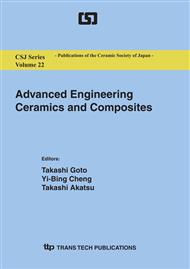p.36
p.41
p.46
p.52
p.57
p.61
p.65
p.70
p.75
Fabrication and Microstructure of Electrically Conductive AlN with High Thermal Conductivity
Abstract:
The electrically conductive AlN with high thermal conductivity were successfully fabricated by sintering AlN with a composite additive of 1wt.% Y2O3 and 4wt.% CeO2 in carbon-reduced atmosphere at over 1600 °C. The sudden increase in electrical conductivity is thought to be caused by transition of grain boundary phase from rare-earth oxide to rare-earth oxycarbide. Their electrical conductivities and thermal conductivities increased with increasing sintering temperature. Additionally, sintering temperature influenced the resultant microstructures.
Info:
Periodical:
Pages:
57-60
Citation:
Online since:
July 2011
Authors:
Price:
Сopyright:
© 2011 Trans Tech Publications Ltd. All Rights Reserved
Share:
Citation:


